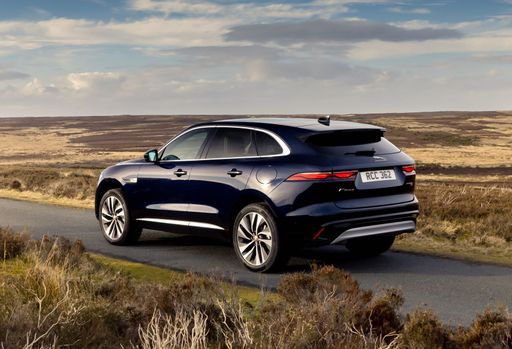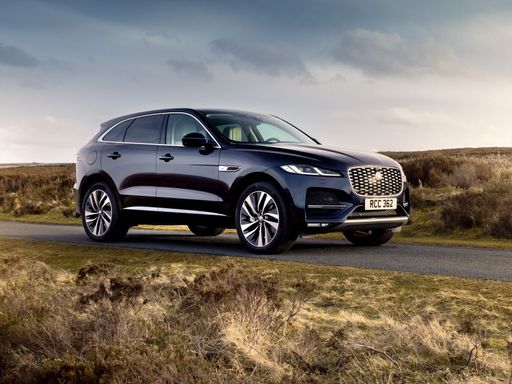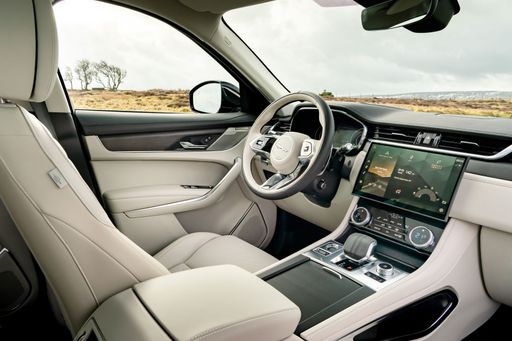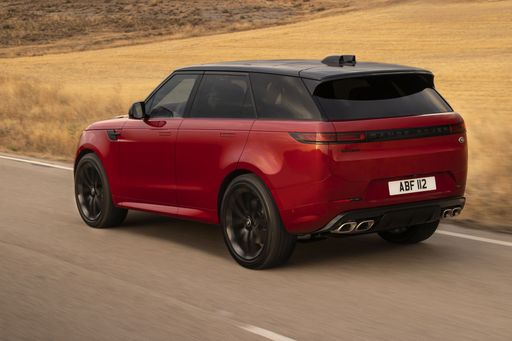Jaguar F-Pace vs Land Rover Range Rover Sport - Differences and prices compared
Costs and Efficiency:
Price and efficiency are key factors when choosing a car – and this is often where the real differences emerge.
Jaguar F-Pace has a noticeable advantage in terms of price – it starts at 56400 £, while the Land Rover Range Rover Sport costs 78600 £. That’s a price difference of around 22200 £.
Fuel consumption also shows a difference: Jaguar F-Pace manages with 1.80 L and is therefore convincingly more efficient than the Land Rover Range Rover Sport with 2.70 L. The difference is about 0.90 L per 100 km.
As for range, the Land Rover Range Rover Sport performs clearly better – achieving up to 118 km, about 54 km more than the Jaguar F-Pace.
Engine and Performance:
Power, torque and acceleration are the classic benchmarks for car enthusiasts – and here, some clear differences start to show.
When it comes to engine power, the Land Rover Range Rover Sport has a minimal edge – offering 635 HP compared to 575 HP. That’s roughly 60 HP more horsepower.
In acceleration from 0 to 100 km/h, the Land Rover Range Rover Sport is slight quicker – completing the sprint in 3.80 s, while the Jaguar F-Pace takes 4 s. That’s about 0.20 s faster.
In terms of top speed, the Land Rover Range Rover Sport performs hardly perceptible better – reaching 290 km/h, while the Jaguar F-Pace tops out at 286 km/h. The difference is around 4 km/h.
There’s also a difference in torque: Land Rover Range Rover Sport pulls to a small extent stronger with 800 Nm compared to 700 Nm. That’s about 100 Nm difference.
Space and Everyday Use:
Beyond pure performance, interior space and usability matter most in daily life. This is where you see which car is more practical and versatile.
Seats: offers more seating capacity – vs .
In curb weight, Jaguar F-Pace is evident lighter – 1951 kg compared to 2390 kg. The difference is around 439 kg.
In terms of boot space, the Land Rover Range Rover Sport offers noticeable more room – 647 L compared to 470 L. That’s a difference of about 177 L.
In maximum load capacity, the Land Rover Range Rover Sport performs barely noticeable better – up to 1491 L, which is about 63 L more than the Jaguar F-Pace.
When it comes to payload, Land Rover Range Rover Sport clearly perceptible takes the win – 830 kg compared to 589 kg. That’s a difference of about 241 kg.
Who comes out on top?
Overall, the Land Rover Range Rover Sport shows itself to be slightly ahead and secures the title of DriveDuel Champion.
It convinces with the more balanced overall package and proves to be the more versatile choice for everyday use.
 @ Jaguar Land Rover Media
@ Jaguar Land Rover Media
Land Rover Range Rover Sport
Costs and Consumption
View detailed analysis
Engine and Performance
View detailed analysis
Dimensions and Body
View detailed analysis
Jaguar F-Pace
Jaguar F-Pace blends the prowling presence of a sports car with the practicality of an SUV, looking elegant while rewarding drivers with lively handling. If you crave something that feels special every time you climb in and prefer style and driving flair over blending into the parking lot, the F-Pace is a classy, slightly cheeky alternative to the usual German suspects.
details @ Jaguar Land Rover Media
@ Jaguar Land Rover Media
 @ Jaguar Land Rover Media
@ Jaguar Land Rover Media
 @ Jaguar Land Rover Media
@ Jaguar Land Rover Media
 @ Jaguar Land Rover Media
@ Jaguar Land Rover Media
 @ Jaguar Land Rover Media
@ Jaguar Land Rover Media
Land Rover Range Rover Sport
The Range Rover Sport pairs unapologetic presence with genuine capability, looking like it belongs on a red carpet while quietly promising to tackle rough tracks when called upon. Inside, the cabin pampers with plush materials and thoughtful tech, making it an irresistible choice for buyers who want luxury, confidence and a touch of adventure.
details @ Jaguar Land Rover Media
@ Jaguar Land Rover Media
 @ Jaguar Land Rover Media
@ Jaguar Land Rover Media
 @ Jaguar Land Rover Media
@ Jaguar Land Rover Media
 @ Jaguar Land Rover Media
@ Jaguar Land Rover Media
|
 @ Jaguar Land Rover Media
@ Jaguar Land Rover Media
|
|
|
|
Costs and Consumption |
|
|---|---|
|
Price
56400 - 100800 £
|
Price
78600 - 175700 £
|
|
Consumption L/100km
1.8 - 12 L
|
Consumption L/100km
2.7 - 11.7 L
|
|
Consumption kWh/100km
-
|
Consumption kWh/100km
-
|
|
Electric Range
64 km
|
Electric Range
116 - 118 km
|
|
Battery Capacity
15.40 kWh
|
Battery Capacity
31.80 kWh
|
|
co2
41 - 274 g/km
|
co2
61 - 266 g/km
|
|
Fuel tank capacity
62 - 83 L
|
Fuel tank capacity
71 - 90 L
|
Dimensions and Body |
|
|---|---|
|
Body Type
SUV
|
Body Type
SUV
|
|
Seats
5
|
Seats
5
|
|
Doors
5
|
Doors
5
|
|
Curb weight
1951 - 2230 kg
|
Curb weight
2390 - 2810 kg
|
|
Trunk capacity
354 - 470 L
|
Trunk capacity
647 L
|
|
Length
4747 - 4762 mm
|
Length
4946 - 4970 mm
|
|
Width
1936 mm
|
Width
2043 mm
|
|
Height
1664 - 1670 mm
|
Height
1814 - 1820 mm
|
|
Max trunk capacity
1299 - 1428 L
|
Max trunk capacity
1491 L
|
|
Payload
457 - 589 kg
|
Payload
640 - 830 kg
|
Engine and Performance |
|
|---|---|
|
Engine Type
Diesel MHEV, Petrol MHEV, Plugin Hybrid, Petrol
|
Engine Type
Plugin Hybrid, Petrol MHEV, Diesel MHEV
|
|
Transmission
Automatic
|
Transmission
Automatic
|
|
Transmission Detail
Automatic Gearbox
|
Transmission Detail
Automatic Gearbox
|
|
Drive Type
All-Wheel Drive
|
Drive Type
All-Wheel Drive
|
|
Power HP
163 - 575 HP
|
Power HP
249 - 635 HP
|
|
Acceleration 0-100km/h
4 - 10.1 s
|
Acceleration 0-100km/h
3.8 - 7.7 s
|
|
Max Speed
195 - 286 km/h
|
Max Speed
206 - 290 km/h
|
|
Torque
380 - 700 Nm
|
Torque
570 - 800 Nm
|
|
Number of Cylinders
4 - 8
|
Number of Cylinders
6 - 8
|
|
Power kW
120 - 423 kW
|
Power kW
183 - 467 kW
|
|
Engine capacity
1997 - 5000 cm3
|
Engine capacity
2997 - 4395 cm3
|
General |
|
|---|---|
|
Model Year
2024
|
Model Year
2025
|
|
CO2 Efficiency Class
G, B
|
CO2 Efficiency Class
B, G
|
|
Brand
Jaguar
|
Brand
Land Rover
|
What drive types are available for the Jaguar F-Pace?
Available configurations include All-Wheel Drive.
The prices and data displayed are estimates based on German list prices and may vary by country. This information is not legally binding.
